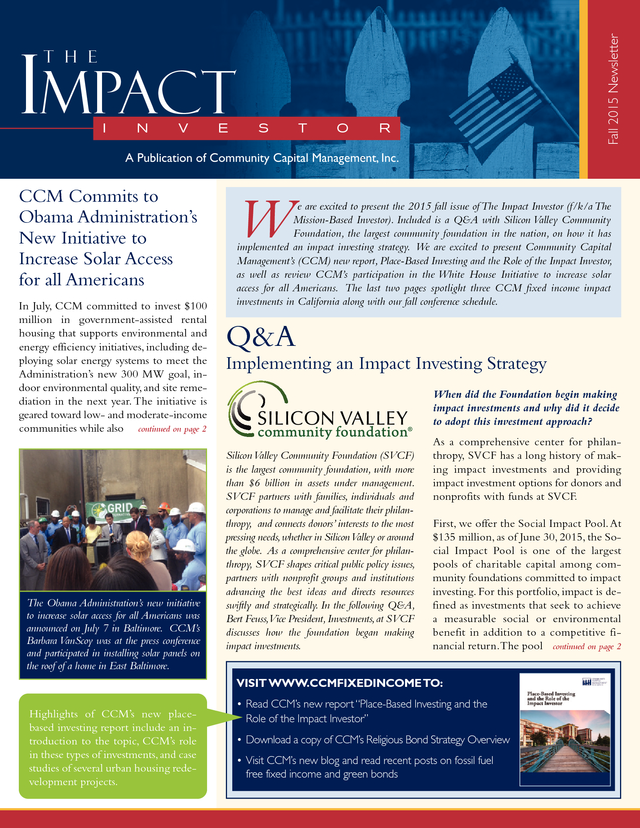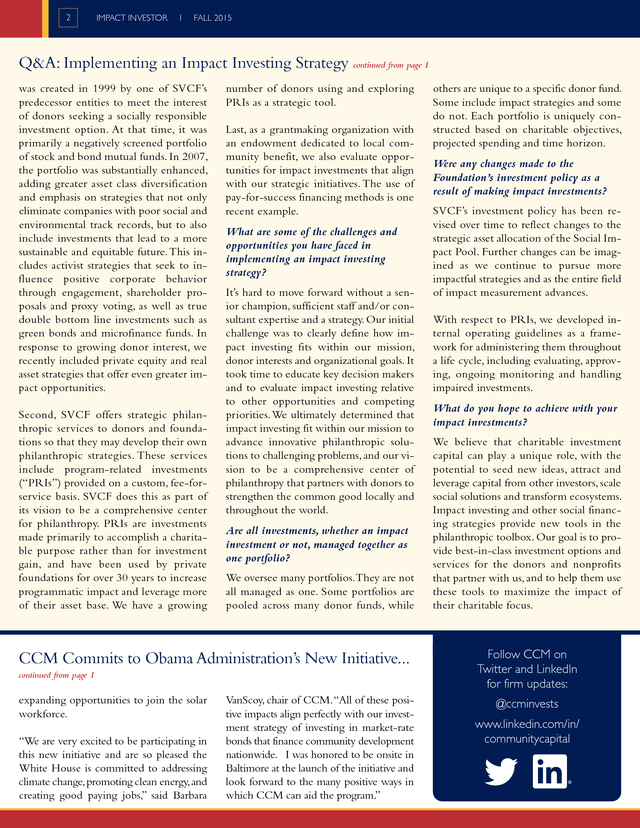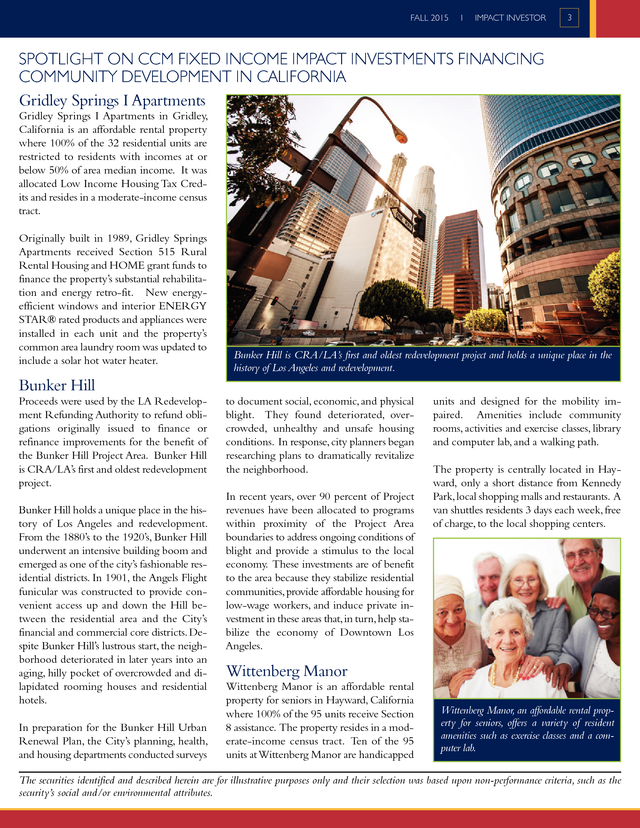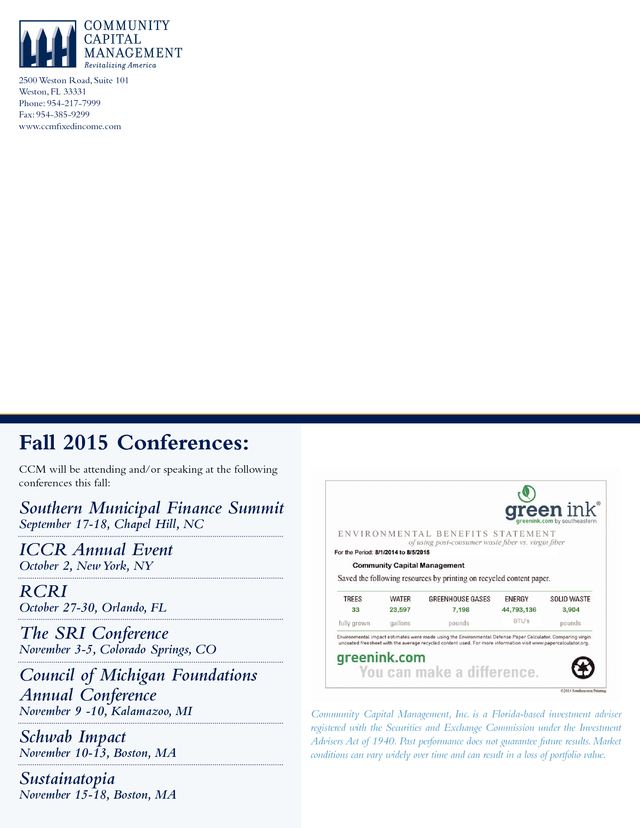Fall 2015 - CCM Commits to Obama Administration’s New Initiative to Increase Solar Access
Community Capital Management, Inc
Description
Fall 2015 Newsletter
T H E
IMPACT
I
N
V
E
S
T
O
R
A Publication of Community Capital Management, Inc.
CCM Commits to
Obama Administration’s
New Initiative to
Increase Solar Access
for all Americans
In July, CCM committed to invest $100
million in government-assisted rental
housing that supports environmental and
energy efficiency initiatives, including deploying solar energy systems to meet the
Administration’s new 300 MW goal, indoor environmental quality, and site remediation in the next year. The initiative is
geared toward low- and moderate-income
communities while also continued on page 2
The Obama Administration’s new initiative
to increase solar access for all Americans was
announced on July 7 in Baltimore. CCM’s
Barbara VanScoy was at the press conference
and participated in installing solar panels on
the roof of a home in East Baltimore.
W
e are excited to present the 2015 fall issue of The Impact Investor (f/k/a The
Mission-Based Investor). Included is a Q&A with Silicon Valley Community
Foundation, the largest community foundation in the nation, on how it has
implemented an impact investing strategy.
We are excited to present Community Capital Management’s (CCM) new report, Place-Based Investing and the Role of the Impact Investor, as well as review CCM’s participation in the White House Initiative to increase solar access for all Americans. The last two pages spotlight three CCM fixed income impact investments in California along with our fall conference schedule. Q&A Implementing an Impact Investing Strategy When did the Foundation begin making impact investments and why did it decide to adopt this investment approach? SiliconValley Community Foundation (SVCF) is the largest community foundation, with more than $6 billion in assets under management. SVCF partners with families, individuals and corporations to manage and facilitate their philanthropy, and connects donors’ interests to the most pressing needs, whether in Silicon Valley or around the globe. As a comprehensive center for philanthropy, SVCF shapes critical public policy issues, partners with nonprofit groups and institutions advancing the best ideas and directs resources swiftly and strategically.
In the following Q&A, Bert Feuss,Vice President, Investments, at SVCF discusses how the foundation began making impact investments. As a comprehensive center for philanthropy, SVCF has a long history of making impact investments and providing impact investment options for donors and nonprofits with funds at SVCF. First, we offer the Social Impact Pool. At $135 million, as of June 30, 2015, the Social Impact Pool is one of the largest pools of charitable capital among community foundations committed to impact investing. For this portfolio, impact is defined as investments that seek to achieve a measurable social or environmental benefit in addition to a competitive financial return.The pool continued on page 2 VISIT WWW.CCMFIXEDINCOME TO: Highlights of CCM’s new placebased investing report include an introduction to the topic, CCM’s role in these types of investments, and case studies of several urban housing redevelopment projects. • Read CCM’s new report “Place-Based Investing and the Role of the Impact Investor” • Download a copy of CCM’s Religious Bond Strategy Overview • Visit CCM’s new blog and read recent posts on fossil fuel free fixed income and green bonds .
2 IMPACT INVESTOR I FALL 2015 Q&A: Implementing an Impact Investing Strategy continued from page 1 was created in 1999 by one of SVCF’s predecessor entities to meet the interest of donors seeking a socially responsible investment option. At that time, it was primarily a negatively screened portfolio of stock and bond mutual funds. In 2007, the portfolio was substantially enhanced, adding greater asset class diversification and emphasis on strategies that not only eliminate companies with poor social and environmental track records, but to also include investments that lead to a more sustainable and equitable future. This includes activist strategies that seek to influence positive corporate behavior through engagement, shareholder proposals and proxy voting, as well as true double bottom line investments such as green bonds and microfinance funds.
In response to growing donor interest, we recently included private equity and real asset strategies that offer even greater impact opportunities. Second, SVCF offers strategic philanthropic services to donors and foundations so that they may develop their own philanthropic strategies. These services include program-related investments (“PRIs”) provided on a custom, fee-forservice basis. SVCF does this as part of its vision to be a comprehensive center for philanthropy.
PRIs are investments made primarily to accomplish a charitable purpose rather than for investment gain, and have been used by private foundations for over 30 years to increase programmatic impact and leverage more of their asset base. We have a growing number of donors using and exploring PRIs as a strategic tool. Last, as a grantmaking organization with an endowment dedicated to local community benefit, we also evaluate opportunities for impact investments that align with our strategic initiatives. The use of pay-for-success financing methods is one recent example. What are some of the challenges and opportunities you have faced in implementing an impact investing strategy? It’s hard to move forward without a senior champion, sufficient staff and/or consultant expertise and a strategy.
Our initial challenge was to clearly define how impact investing fits within our mission, donor interests and organizational goals. It took time to educate key decision makers and to evaluate impact investing relative to other opportunities and competing priorities. We ultimately determined that impact investing fit within our mission to advance innovative philanthropic solutions to challenging problems, and our vision to be a comprehensive center of philanthropy that partners with donors to strengthen the common good locally and throughout the world. Are all investments, whether an impact investment or not, managed together as one portfolio? We oversee many portfolios.They are not all managed as one.
Some portfolios are pooled across many donor funds, while CCM Commits to Obama Administration’s New Initiative... continued from page 1 expanding opportunities to join the solar workforce. “We are very excited to be participating in this new initiative and are so pleased the White House is committed to addressing climate change, promoting clean energy, and creating good paying jobs,” said Barbara VanScoy, chair of CCM. “All of these positive impacts align perfectly with our investment strategy of investing in market-rate bonds that finance community development nationwide. I was honored to be onsite in Baltimore at the launch of the initiative and look forward to the many positive ways in which CCM can aid the program.” others are unique to a specific donor fund. Some include impact strategies and some do not.
Each portfolio is uniquely constructed based on charitable objectives, projected spending and time horizon. Were any changes made to the Foundation’s investment policy as a result of making impact investments? SVCF’s investment policy has been revised over time to reflect changes to the strategic asset allocation of the Social Impact Pool. Further changes can be imagined as we continue to pursue more impactful strategies and as the entire field of impact measurement advances. With respect to PRIs, we developed internal operating guidelines as a framework for administering them throughout a life cycle, including evaluating, approving, ongoing monitoring and handling impaired investments. What do you hope to achieve with your impact investments? We believe that charitable investment capital can play a unique role, with the potential to seed new ideas, attract and leverage capital from other investors, scale social solutions and transform ecosystems. Impact investing and other social financing strategies provide new tools in the philanthropic toolbox. Our goal is to provide best-in-class investment options and services for the donors and nonprofits that partner with us, and to help them use these tools to maximize the impact of their charitable focus. Follow CCM on Twitter and LinkedIn for firm updates: @ccminvests www.linkedin.com/in/ communitycapital .
FALL 2015 I IMPACT INVESTOR 3 SPOTLIGHT ON CCM FIXED INCOME IMPACT INVESTMENTS FINANCING COMMUNITY DEVELOPMENT IN CALIFORNIA Gridley Springs I Apartments Gridley Springs I Apartments in Gridley, California is an affordable rental property where 100% of the 32 residential units are restricted to residents with incomes at or below 50% of area median income. It was allocated Low Income Housing Tax Credits and resides in a moderate-income census tract. Originally built in 1989, Gridley Springs Apartments received Section 515 Rural Rental Housing and HOME grant funds to finance the property’s substantial rehabilitation and energy retro-fit. New energyefficient windows and interior ENERGY STAR® rated products and appliances were installed in each unit and the property’s common area laundry room was updated to include a solar hot water heater. Bunker Hill is CRA/LA’s first and oldest redevelopment project and holds a unique place in the history of Los Angeles and redevelopment. Bunker Hill Proceeds were used by the LA Redevelopment Refunding Authority to refund obligations originally issued to finance or refinance improvements for the benefit of the Bunker Hill Project Area. Bunker Hill is CRA/LA’s first and oldest redevelopment project. Bunker Hill holds a unique place in the history of Los Angeles and redevelopment. From the 1880’s to the 1920’s, Bunker Hill underwent an intensive building boom and emerged as one of the city’s fashionable residential districts.
In 1901, the Angels Flight funicular was constructed to provide convenient access up and down the Hill between the residential area and the City’s financial and commercial core districts. Despite Bunker Hill’s lustrous start, the neighborhood deteriorated in later years into an aging, hilly pocket of overcrowded and dilapidated rooming houses and residential hotels. In preparation for the Bunker Hill Urban Renewal Plan, the City’s planning, health, and housing departments conducted surveys to document social, economic, and physical blight. They found deteriorated, overcrowded, unhealthy and unsafe housing conditions.
In response, city planners began researching plans to dramatically revitalize the neighborhood. In recent years, over 90 percent of Project revenues have been allocated to programs within proximity of the Project Area boundaries to address ongoing conditions of blight and provide a stimulus to the local economy. These investments are of benefit to the area because they stabilize residential communities, provide affordable housing for low-wage workers, and induce private investment in these areas that, in turn, help stabilize the economy of Downtown Los Angeles. units and designed for the mobility impaired. Amenities include community rooms, activities and exercise classes, library and computer lab, and a walking path. The property is centrally located in Hayward, only a short distance from Kennedy Park, local shopping malls and restaurants.
A van shuttles residents 3 days each week, free of charge, to the local shopping centers. Wittenberg Manor Wittenberg Manor is an affordable rental property for seniors in Hayward, California where 100% of the 95 units receive Section 8 assistance. The property resides in a moderate-income census tract. Ten of the 95 units at Wittenberg Manor are handicapped Wittenberg Manor, an affordable rental property for seniors, offers a variety of resident amenities such as exercise classes and a computer lab. The securities identified and described herein are for illustrative purposes only and their selection was based upon non-performance criteria, such as the security’s social and/or environmental attributes. .
2500 Weston Road, Suite 101 Weston, FL 33331 Phone: 954-217-7999 Fax: 954-385-9299 www.ccmï¬xedincome.com Fall 2015 Conferences: CCM will be attending and/or speaking at the following conferences this fall: Southern Municipal Finance Summit September 17-18, Chapel Hill, NC ICCR Annual Event October 2, New York, NY RCRI October 27-30, Orlando, FL The SRI Conference November 3-5, Colorado Springs, CO Council of Michigan Foundations Annual Conference November 9 -10, Kalamazoo, MI Schwab Impact November 10-13, Boston, MA Sustainatopia November 15-18, Boston, MA Community Capital Management, Inc. is a Florida-based investment adviser registered with the Securities and Exchange Commission under the Investment Advisers Act of 1940. Past performance does not guarantee future results. Market conditions can vary widely over time and can result in a loss of portfolio value. .
We are excited to present Community Capital Management’s (CCM) new report, Place-Based Investing and the Role of the Impact Investor, as well as review CCM’s participation in the White House Initiative to increase solar access for all Americans. The last two pages spotlight three CCM fixed income impact investments in California along with our fall conference schedule. Q&A Implementing an Impact Investing Strategy When did the Foundation begin making impact investments and why did it decide to adopt this investment approach? SiliconValley Community Foundation (SVCF) is the largest community foundation, with more than $6 billion in assets under management. SVCF partners with families, individuals and corporations to manage and facilitate their philanthropy, and connects donors’ interests to the most pressing needs, whether in Silicon Valley or around the globe. As a comprehensive center for philanthropy, SVCF shapes critical public policy issues, partners with nonprofit groups and institutions advancing the best ideas and directs resources swiftly and strategically.
In the following Q&A, Bert Feuss,Vice President, Investments, at SVCF discusses how the foundation began making impact investments. As a comprehensive center for philanthropy, SVCF has a long history of making impact investments and providing impact investment options for donors and nonprofits with funds at SVCF. First, we offer the Social Impact Pool. At $135 million, as of June 30, 2015, the Social Impact Pool is one of the largest pools of charitable capital among community foundations committed to impact investing. For this portfolio, impact is defined as investments that seek to achieve a measurable social or environmental benefit in addition to a competitive financial return.The pool continued on page 2 VISIT WWW.CCMFIXEDINCOME TO: Highlights of CCM’s new placebased investing report include an introduction to the topic, CCM’s role in these types of investments, and case studies of several urban housing redevelopment projects. • Read CCM’s new report “Place-Based Investing and the Role of the Impact Investor” • Download a copy of CCM’s Religious Bond Strategy Overview • Visit CCM’s new blog and read recent posts on fossil fuel free fixed income and green bonds .
2 IMPACT INVESTOR I FALL 2015 Q&A: Implementing an Impact Investing Strategy continued from page 1 was created in 1999 by one of SVCF’s predecessor entities to meet the interest of donors seeking a socially responsible investment option. At that time, it was primarily a negatively screened portfolio of stock and bond mutual funds. In 2007, the portfolio was substantially enhanced, adding greater asset class diversification and emphasis on strategies that not only eliminate companies with poor social and environmental track records, but to also include investments that lead to a more sustainable and equitable future. This includes activist strategies that seek to influence positive corporate behavior through engagement, shareholder proposals and proxy voting, as well as true double bottom line investments such as green bonds and microfinance funds.
In response to growing donor interest, we recently included private equity and real asset strategies that offer even greater impact opportunities. Second, SVCF offers strategic philanthropic services to donors and foundations so that they may develop their own philanthropic strategies. These services include program-related investments (“PRIs”) provided on a custom, fee-forservice basis. SVCF does this as part of its vision to be a comprehensive center for philanthropy.
PRIs are investments made primarily to accomplish a charitable purpose rather than for investment gain, and have been used by private foundations for over 30 years to increase programmatic impact and leverage more of their asset base. We have a growing number of donors using and exploring PRIs as a strategic tool. Last, as a grantmaking organization with an endowment dedicated to local community benefit, we also evaluate opportunities for impact investments that align with our strategic initiatives. The use of pay-for-success financing methods is one recent example. What are some of the challenges and opportunities you have faced in implementing an impact investing strategy? It’s hard to move forward without a senior champion, sufficient staff and/or consultant expertise and a strategy.
Our initial challenge was to clearly define how impact investing fits within our mission, donor interests and organizational goals. It took time to educate key decision makers and to evaluate impact investing relative to other opportunities and competing priorities. We ultimately determined that impact investing fit within our mission to advance innovative philanthropic solutions to challenging problems, and our vision to be a comprehensive center of philanthropy that partners with donors to strengthen the common good locally and throughout the world. Are all investments, whether an impact investment or not, managed together as one portfolio? We oversee many portfolios.They are not all managed as one.
Some portfolios are pooled across many donor funds, while CCM Commits to Obama Administration’s New Initiative... continued from page 1 expanding opportunities to join the solar workforce. “We are very excited to be participating in this new initiative and are so pleased the White House is committed to addressing climate change, promoting clean energy, and creating good paying jobs,” said Barbara VanScoy, chair of CCM. “All of these positive impacts align perfectly with our investment strategy of investing in market-rate bonds that finance community development nationwide. I was honored to be onsite in Baltimore at the launch of the initiative and look forward to the many positive ways in which CCM can aid the program.” others are unique to a specific donor fund. Some include impact strategies and some do not.
Each portfolio is uniquely constructed based on charitable objectives, projected spending and time horizon. Were any changes made to the Foundation’s investment policy as a result of making impact investments? SVCF’s investment policy has been revised over time to reflect changes to the strategic asset allocation of the Social Impact Pool. Further changes can be imagined as we continue to pursue more impactful strategies and as the entire field of impact measurement advances. With respect to PRIs, we developed internal operating guidelines as a framework for administering them throughout a life cycle, including evaluating, approving, ongoing monitoring and handling impaired investments. What do you hope to achieve with your impact investments? We believe that charitable investment capital can play a unique role, with the potential to seed new ideas, attract and leverage capital from other investors, scale social solutions and transform ecosystems. Impact investing and other social financing strategies provide new tools in the philanthropic toolbox. Our goal is to provide best-in-class investment options and services for the donors and nonprofits that partner with us, and to help them use these tools to maximize the impact of their charitable focus. Follow CCM on Twitter and LinkedIn for firm updates: @ccminvests www.linkedin.com/in/ communitycapital .
FALL 2015 I IMPACT INVESTOR 3 SPOTLIGHT ON CCM FIXED INCOME IMPACT INVESTMENTS FINANCING COMMUNITY DEVELOPMENT IN CALIFORNIA Gridley Springs I Apartments Gridley Springs I Apartments in Gridley, California is an affordable rental property where 100% of the 32 residential units are restricted to residents with incomes at or below 50% of area median income. It was allocated Low Income Housing Tax Credits and resides in a moderate-income census tract. Originally built in 1989, Gridley Springs Apartments received Section 515 Rural Rental Housing and HOME grant funds to finance the property’s substantial rehabilitation and energy retro-fit. New energyefficient windows and interior ENERGY STAR® rated products and appliances were installed in each unit and the property’s common area laundry room was updated to include a solar hot water heater. Bunker Hill is CRA/LA’s first and oldest redevelopment project and holds a unique place in the history of Los Angeles and redevelopment. Bunker Hill Proceeds were used by the LA Redevelopment Refunding Authority to refund obligations originally issued to finance or refinance improvements for the benefit of the Bunker Hill Project Area. Bunker Hill is CRA/LA’s first and oldest redevelopment project. Bunker Hill holds a unique place in the history of Los Angeles and redevelopment. From the 1880’s to the 1920’s, Bunker Hill underwent an intensive building boom and emerged as one of the city’s fashionable residential districts.
In 1901, the Angels Flight funicular was constructed to provide convenient access up and down the Hill between the residential area and the City’s financial and commercial core districts. Despite Bunker Hill’s lustrous start, the neighborhood deteriorated in later years into an aging, hilly pocket of overcrowded and dilapidated rooming houses and residential hotels. In preparation for the Bunker Hill Urban Renewal Plan, the City’s planning, health, and housing departments conducted surveys to document social, economic, and physical blight. They found deteriorated, overcrowded, unhealthy and unsafe housing conditions.
In response, city planners began researching plans to dramatically revitalize the neighborhood. In recent years, over 90 percent of Project revenues have been allocated to programs within proximity of the Project Area boundaries to address ongoing conditions of blight and provide a stimulus to the local economy. These investments are of benefit to the area because they stabilize residential communities, provide affordable housing for low-wage workers, and induce private investment in these areas that, in turn, help stabilize the economy of Downtown Los Angeles. units and designed for the mobility impaired. Amenities include community rooms, activities and exercise classes, library and computer lab, and a walking path. The property is centrally located in Hayward, only a short distance from Kennedy Park, local shopping malls and restaurants.
A van shuttles residents 3 days each week, free of charge, to the local shopping centers. Wittenberg Manor Wittenberg Manor is an affordable rental property for seniors in Hayward, California where 100% of the 95 units receive Section 8 assistance. The property resides in a moderate-income census tract. Ten of the 95 units at Wittenberg Manor are handicapped Wittenberg Manor, an affordable rental property for seniors, offers a variety of resident amenities such as exercise classes and a computer lab. The securities identified and described herein are for illustrative purposes only and their selection was based upon non-performance criteria, such as the security’s social and/or environmental attributes. .
2500 Weston Road, Suite 101 Weston, FL 33331 Phone: 954-217-7999 Fax: 954-385-9299 www.ccmï¬xedincome.com Fall 2015 Conferences: CCM will be attending and/or speaking at the following conferences this fall: Southern Municipal Finance Summit September 17-18, Chapel Hill, NC ICCR Annual Event October 2, New York, NY RCRI October 27-30, Orlando, FL The SRI Conference November 3-5, Colorado Springs, CO Council of Michigan Foundations Annual Conference November 9 -10, Kalamazoo, MI Schwab Impact November 10-13, Boston, MA Sustainatopia November 15-18, Boston, MA Community Capital Management, Inc. is a Florida-based investment adviser registered with the Securities and Exchange Commission under the Investment Advisers Act of 1940. Past performance does not guarantee future results. Market conditions can vary widely over time and can result in a loss of portfolio value. .

















